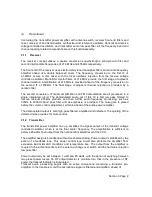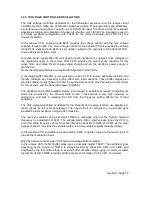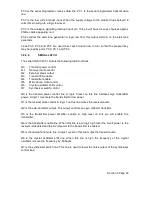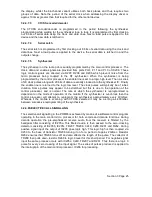
3.2.2.2
TRANSMIT AUDIO PROCESSING
The majority of the transmit audio circuitry is located on the control PCB. The primary input is
at PIN 8 of the microphone input socket SK201. The active microphone derives its power
source from the transceiver via the emitter follower transistor TR229. This transistor provides
a well decoupled, low noise do supply by effectively amplifying the base capacitance of C301.
The supply to the microphone preamplifier is coupled via R311 which also presents the
optimum load impedance.
The microphone signal is then processed by one quarter of quad op amp IC210. This stage is
configured as a third order high pass filter with a cut-off frequency of 300Hz. Capacitors C307,
C308 and C309 set the cut-off frequency. This filter has unity gain and the signal output
appears at PIN 1 of IC210.
The input to the next stage passes via the microphone mute gate provided by transistor
TR228. When this transistor is activated by the microprocessor, the muting action is achieved
by causing the bias point of the OP AMP to be saturated at the output PIN 7 (close to +ve
supply).
Following the mute gate is the microphone amplifier stage using another OP AMP of IC210.
The input of the microphone amplifier is at PIN 6 and the output appears at PIN 7. This stage
may provide more than 30dB voltage gain and adjustment is provided by R322, the
microphone gain potentiometer. The output of the microphone amplifier stage may pass
directly to the following stage which is a clipper circuit. Alternatively the signal may pass via
the CTCSS high pass filter which has the input at PIN 22 of IC204 and output at PIN 20. When
CTCSS is fitted IC204 provides additional rejection of low frequency microphone audio below
300Hz, to ensure a minimum disturbance of the CTCSS encode tone. The CTCSS high pass
filter provides no additional gain; care must be taken to prevent signal level overload at the
high pass filter input.
The resistor divider of R391 and R392 ensure input levels are kept low. The value of the gain
setting resistor R377 is chosen to recover the signal loss caused by the attenuator.
At the input to the clipper stage, pre-emphasis is provided by C311 and R324, or when
CTCSS is fitted, C247 and R377 provide the pre-emphasis.
The clipper stage provides sufficient gain to cause the output waveform, at PIN 8 of the OP
AMP, to reach the limiting levels of the supply voltage and ground. For the OP AMP used this
is approximately 8 volts peak-to-peak.
The processed microphone audio is fed to a summing amplifier stage using the remaining OP
AMP in the quad package IC210. At the summing point of PIN 13, the microphone audio is
combined with the encode signalling options of selective call or CTCSS.
The gain of this summing amplifier is adjusted by R316 which is the deviation setting
potentiometer.
The output of the summing amplifier appears at PIN 14 of IC210, this signal passes to the
radio PCB via the flexible printed circuit.
Section 3 Page 11
















































